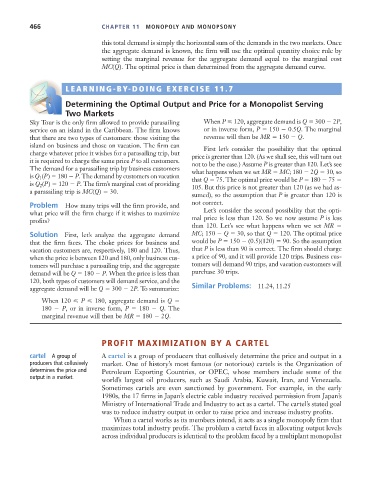Page 492 - Microeconomics, Fourth Edition
P. 492
c11monopolyandmonopsony.qxd 7/14/10 7:58 PM Page 466
466 CHAPTER 11 MONOPOLY AND MONOPSONY
this total demand is simply the horizontal sum of the demands in the two markets. Once
the aggregate demand is known, the firm will use the optimal quantity choice rule by
setting the marginal revenue for the aggregate demand equal to the marginal cost
MC(Q). The optimal price is then determined from the aggregate demand curve.
LEARNING-BY-DOING EXERCISE 11.7
S
E D
Determining the Optimal Output and Price for a Monopolist Serving
Two Markets
Sky Tour is the only firm allowed to provide parasailing When P 120, aggregate demand is Q 300 2P,
service on an island in the Caribbean. The firm knows or in inverse form, P 150 0.5Q. The marginal
that there are two types of customers: those visiting the revenue will then be MR 150 Q.
island on business and those on vacation. The firm can First let’s consider the possibility that the optimal
charge whatever price it wishes for a parasailing trip, but price is greater than 120. (As we shall see, this will turn out
it is required to charge the same price P to all customers.
The demand for a parasailing trip by business customers not to be the case.) Assume P is greater than 120. Let’s see
what happens when we set MR MC; 180 2Q 30, so
is Q 1 (P) 180 P. The demand by customers on vacation that Q 75. The optimal price would be P 180 75
is Q 2 (P) 120 P. The firm’s marginal cost of providing
105. But this price is not greater than 120 (as we had as-
a parasailing trip is MC(Q) 30.
sumed), so the assumption that P is greater than 120 is
Problem How many trips will the firm provide, and not correct.
what price will the firm charge if it wishes to maximize Let’s consider the second possibility that the opti-
mal price is less than 120. So we now assume P is less
profits?
than 120. Let’s see what happens when we set MR
Solution First, let’s analyze the aggregate demand MC; 150 Q 30, so that Q 120. The optimal price
that the firm faces. The choke prices for business and would be P 150 (0.5)(120) 90. So the assumption
vacation customers are, respectively, 180 and 120. Thus, that P is less than 90 is correct. The firm should charge
when the price is between 120 and 180, only business cus- a price of 90, and it will provide 120 trips. Business cus-
tomers will purchase a parasailing trip, and the aggregate tomers will demand 90 trips, and vacation customers will
demand will be Q 180 P. When the price is less than purchase 30 trips.
120, both types of customers will demand service, and the
aggregate demand will be Q 300 2P. To summarize: Similar Problems: 11.24, 11.25
When 120 P 180, aggregate demand is Q
180 P, or in inverse form, P 180 Q. The
marginal revenue will then be MR 180 2Q.
PROFIT MAXIMIZATION BY A CARTEL
cartel A group of A cartel is a group of producers that collusively determine the price and output in a
producers that collusively market. One of history’s most famous (or notorious) cartels is the Organization of
determines the price and Petroleum Exporting Countries, or OPEC, whose members include some of the
output in a market. world’s largest oil producers, such as Saudi Arabia, Kuwait, Iran, and Venezuela.
Sometimes cartels are even sanctioned by government. For example, in the early
1980s, the 17 firms in Japan’s electric cable industry received permission from Japan’s
Ministry of International Trade and Industry to act as a cartel. The cartel’s stated goal
was to reduce industry output in order to raise price and increase industry profits.
When a cartel works as its members intend, it acts as a single monopoly firm that
maximizes total industry profit. The problem a cartel faces in allocating output levels
across individual producers is identical to the problem faced by a multiplant monopolist

